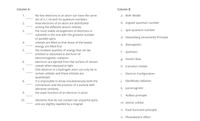
Chemistry
10th Edition
ISBN: 9781305957404
Author: Steven S. Zumdahl, Susan A. Zumdahl, Donald J. DeCoste
Publisher: Cengage Learning
expand_more
expand_more
format_list_bulleted
Concept explainers
Question
thumb_up100%

Transcribed Image Text:**Column A and Column B Matching Exercise**
This exercise consists of two columns with scientific principles and concepts related to quantum mechanics and atomic theory. The task is to match each statement or description in Column A with the correct term or principle in Column B.
**Column A:**
1. No two electrons in an atom can have the same set of n, l, ml and ms quantum numbers.
2. How electrons of an atom are distributed among the different atomic orbitals.
3. The most stable arrangement of electrons in subshells is the one with the greatest number of parallel spins.
4. Orbitals are filled so that those of the lowest energy are filled first.
5. The smallest quantity of energy that can be emitted or absorbed in the form of electromagnetic radiation.
6. Electrons are ejected from the surface of certain metals when exposed to light.
7. One electron in a hydrogen atom can only be in certain orbitals and these orbitals are quantized.
8. It is impossible to know simultaneously both the momentum and the position of a particle with absolute certainty.
9. The wave function of an electron in an atom.
10. Elements that do not contain net unpaired spins and are slightly repelled by a magnet.
**Column B:**
a. Bohr Model
b. Angular quantum number
c. Spin quantum number
d. Heisenberg Uncertainty Principle
e. Diamagnetic
f. Quantum
g. Hund's Rule
h. Transition metals
i. Electron Configuration
j. Blackbody radiation
k. Paramagnetic
l. Aufbau principle
m. Atomic orbital
n. Pauli Exclusion principle
o. Photoelectric effect
**Instructions:** Match the descriptions in Column A to the correct terms in Column B by writing the appropriate letter next to each number in Column A.
Expert Solution
This question has been solved!
Explore an expertly crafted, step-by-step solution for a thorough understanding of key concepts.
This is a popular solution
Trending nowThis is a popular solution!
Step by stepSolved in 2 steps

Knowledge Booster
Learn more about
Need a deep-dive on the concept behind this application? Look no further. Learn more about this topic, chemistry and related others by exploring similar questions and additional content below.Similar questions
- 1. How many unpaired electrons are in the nitrogen atom? This atom is A. Paramagnetic B. Diamagnetic 2. How many unpaired electrons are in the vanadium atom? This atom is A. Paramagnetic B. Diamagneticarrow_forwardUsing complete subshell notation, match the predicted electron configuration of each of the following atoms. (match one from the top (letter) to one at the bottom (number). a. Sb b. P c. Sm d. V e. C 1. 1s22s22p63s23p3 2. 1s22s22p63s23p63d104s24p64d105s25p3 3. 1s22s22p2 4. 1s22s22p63s23p63d104s24p64d105s25p66s24f6 5. 1s22s22p63s23p64s23d3arrow_forwardО Which of the statements most accurately describes the following electron configuration? 1 ↓ 1 a. It is a valid configuration for a ground state atom. b. It violates the aufbau principle. c. It is invalid and violates multiple rules/principles. d. It violates the Pauli exclusion principle. e. It violates Hund's rule.arrow_forward
- 1. How many unpaired electrons are in the carbon atom? A. Paramagnetic B. Diamagnetic This atom is 2. How many unpaired electrons are in the cobalt atom? A. Paramagnetic B. Diamagnetic This atom isarrow_forwardWhat hydrogen atomic orbital has: A. One radial node and one angular node? B. no radial nodes and 2 angular nodes?arrow_forwardHow many nodal surfaces are associated with the following orbitals? a. 4s orbital nodal surface(s) b. 2s orbital nodal surface(s) c. 2p orbital nodal surface(s)arrow_forward
- harrow_forwardWhich of the following statements about an electron is TRUE according to the quantum mechanical model of the atom? A. The shape of an orbital is determined mathematically from the wavefunction of an electron B. The position and velocity of an electron can simultaneously be determined very accurately C. A single electron can interfere with itself O All of A, B, and C O Conly Both A and C O A only B onlyarrow_forwardWhich rule states that the electrons go in singularly until you half fill the orbital set then begin pairing of electrons? A. Hunds Rule B. Paul Exclusion principle C. Bohrs Rule D. Aufbau Principlearrow_forward
arrow_back_ios
arrow_forward_ios
Recommended textbooks for you
 ChemistryChemistryISBN:9781305957404Author:Steven S. Zumdahl, Susan A. Zumdahl, Donald J. DeCostePublisher:Cengage Learning
ChemistryChemistryISBN:9781305957404Author:Steven S. Zumdahl, Susan A. Zumdahl, Donald J. DeCostePublisher:Cengage Learning ChemistryChemistryISBN:9781259911156Author:Raymond Chang Dr., Jason Overby ProfessorPublisher:McGraw-Hill Education
ChemistryChemistryISBN:9781259911156Author:Raymond Chang Dr., Jason Overby ProfessorPublisher:McGraw-Hill Education Principles of Instrumental AnalysisChemistryISBN:9781305577213Author:Douglas A. Skoog, F. James Holler, Stanley R. CrouchPublisher:Cengage Learning
Principles of Instrumental AnalysisChemistryISBN:9781305577213Author:Douglas A. Skoog, F. James Holler, Stanley R. CrouchPublisher:Cengage Learning Organic ChemistryChemistryISBN:9780078021558Author:Janice Gorzynski Smith Dr.Publisher:McGraw-Hill Education
Organic ChemistryChemistryISBN:9780078021558Author:Janice Gorzynski Smith Dr.Publisher:McGraw-Hill Education Chemistry: Principles and ReactionsChemistryISBN:9781305079373Author:William L. Masterton, Cecile N. HurleyPublisher:Cengage Learning
Chemistry: Principles and ReactionsChemistryISBN:9781305079373Author:William L. Masterton, Cecile N. HurleyPublisher:Cengage Learning Elementary Principles of Chemical Processes, Bind...ChemistryISBN:9781118431221Author:Richard M. Felder, Ronald W. Rousseau, Lisa G. BullardPublisher:WILEY
Elementary Principles of Chemical Processes, Bind...ChemistryISBN:9781118431221Author:Richard M. Felder, Ronald W. Rousseau, Lisa G. BullardPublisher:WILEY

Chemistry
Chemistry
ISBN:9781305957404
Author:Steven S. Zumdahl, Susan A. Zumdahl, Donald J. DeCoste
Publisher:Cengage Learning

Chemistry
Chemistry
ISBN:9781259911156
Author:Raymond Chang Dr., Jason Overby Professor
Publisher:McGraw-Hill Education

Principles of Instrumental Analysis
Chemistry
ISBN:9781305577213
Author:Douglas A. Skoog, F. James Holler, Stanley R. Crouch
Publisher:Cengage Learning

Organic Chemistry
Chemistry
ISBN:9780078021558
Author:Janice Gorzynski Smith Dr.
Publisher:McGraw-Hill Education

Chemistry: Principles and Reactions
Chemistry
ISBN:9781305079373
Author:William L. Masterton, Cecile N. Hurley
Publisher:Cengage Learning

Elementary Principles of Chemical Processes, Bind...
Chemistry
ISBN:9781118431221
Author:Richard M. Felder, Ronald W. Rousseau, Lisa G. Bullard
Publisher:WILEY